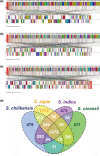Genomic analysis reveals high intra-species diversity of Shewanella algae
- PMID: 35143386
- PMCID: PMC8942018
- DOI: 10.1099/mgen.0.000786
Genomic analysis reveals high intra-species diversity of Shewanella algae
Abstract
Shewanella algae is widely distributed in marine and freshwater habitats, and has been proved to be an emerging marine zoonotic and human pathogen. However, the genomic characteristics and pathogenicity of Shewanella algae are unclear. Here, the whole-genome features of 55 S. algae strains isolated from different sources were described. Pan-genome analysis yielded 2863 (19.4 %) genes shared among all strains. Functional annotation of the core genome showed that the main functions are focused on basic lifestyle such as metabolism and energy production. Meanwhile, the phylogenetic tree of the single nucleotide polymorphisms (SNPs) of core genome divided the 55 strains into three clades, with the majority of strains from China falling into the first two clades. As for the accessory genome, 167 genomic islands (GIs) and 65 phage-related elements were detected. The CRISPR-Cas system with a high degree of confidence was predicted in 23 strains. The GIs carried a suite of virulence genes and mobile genetic elements, while prophages contained several transposases and integrases. Horizontal genes transfer based on homology analysis indicated that these GIs and prophages were parts of major drivers for the evolution and the environmental adaptation of S. algae. In addition, a rich putative virulence-associated gene pool was found. Eight classes of antibiotic-associated resistance genes were detected, and the carriage rate of β-lactam resistance genes was 100 %. In conclusion, S. algae exhibits a high intra-species diversity in the aspects of population structure, virulence-associated genes and potential drug resistance, which is helpful for its evolution in pathogenesis and environmental adaptability.
Keywords: Shewanella algae; diversity; drug resistance; environmental adaptability; genome characteristics; virulence-associated genes.
Conflict of interest statement
The authors declare that there are no conflicts of interest.
Figures






Similar articles
-
Whole-genome characterization of Shewanella algae strain SYT3 isolated from seawater reveals insight into hemolysis.Future Microbiol. 2018 Dec;13:1709-1717. doi: 10.2217/fmb-2018-0267. Epub 2018 Nov 27. Future Microbiol. 2018. PMID: 30477345
-
Pangenome analysis of Shewanella xiamenensis revealed important genetic traits concerning genetic diversity, pathogenicity and antibiotic resistance.BMC Genomics. 2024 Feb 27;25(1):216. doi: 10.1186/s12864-024-10146-z. BMC Genomics. 2024. PMID: 38413855 Free PMC article.
-
Reassessment of the Listeria monocytogenes pan-genome reveals dynamic integration hotspots and mobile genetic elements as major components of the accessory genome.BMC Genomics. 2013 Jan 22;14:47. doi: 10.1186/1471-2164-14-47. BMC Genomics. 2013. PMID: 23339658 Free PMC article.
-
The Bacterial Guide to Designing a Diversified Gene Portfolio.2020 May 1. In: Tettelin H, Medini D, editors. The Pangenome: Diversity, Dynamics and Evolution of Genomes [Internet]. Cham (CH): Springer; 2020. 2020 May 1. In: Tettelin H, Medini D, editors. The Pangenome: Diversity, Dynamics and Evolution of Genomes [Internet]. Cham (CH): Springer; 2020. PMID: 32633915 Free Books & Documents. Review.
-
The bacterial species definition in the genomic era.Philos Trans R Soc Lond B Biol Sci. 2006 Nov 29;361(1475):1929-40. doi: 10.1098/rstb.2006.1920. Philos Trans R Soc Lond B Biol Sci. 2006. PMID: 17062412 Free PMC article. Review.
Cited by
-
Shewanella algae, an Emerging Human Pathogen: A Series of Four Cases From a Portuguese Hospital.Cureus. 2023 Jan 12;15(1):e33686. doi: 10.7759/cureus.33686. eCollection 2023 Jan. Cureus. 2023. PMID: 36788829 Free PMC article.
-
Comparative genome analysis of the genus Shewanella unravels the association of key genetic traits with known and potential pathogenic lineages.Front Microbiol. 2023 Feb 28;14:1124225. doi: 10.3389/fmicb.2023.1124225. eCollection 2023. Front Microbiol. 2023. PMID: 36925471 Free PMC article.
-
Genetic insights into Shewanella spp., progenitor of the bla OXA-48-like genes: a large-scale study.Microb Genom. 2025 Jun;11(6):001417. doi: 10.1099/mgen.0.001417. Microb Genom. 2025. PMID: 40471180 Free PMC article.
-
Genome characterization of Shewanella algae in Hainan Province, China.Front Microbiol. 2024 Oct 2;15:1474871. doi: 10.3389/fmicb.2024.1474871. eCollection 2024. Front Microbiol. 2024. PMID: 39417074 Free PMC article.
-
Virulence, antibiotic resistance phenotypes and molecular characterisation of Vibrio furnissii isolates from patients with diarrhoea.BMC Infect Dis. 2024 Apr 19;24(1):412. doi: 10.1186/s12879-024-09273-5. BMC Infect Dis. 2024. PMID: 38641583 Free PMC article.
References
-
- Aigle A, Bonin P, Fernandez-Nunez N, Loriod B, Guasco S, et al. The nature of the electron acceptor (MnIV/NO3) triggers the differential expression of genes associated with stress and ammonium limitation responses in Shewanella algae C6G3. FEMS Microbiol Lett. 2018;365 doi: 10.1093/femsle/fny068. - DOI - PubMed
Publication types
MeSH terms
Substances
Supplementary concepts
LinkOut - more resources
Full Text Sources
Molecular Biology Databases
Research Materials

